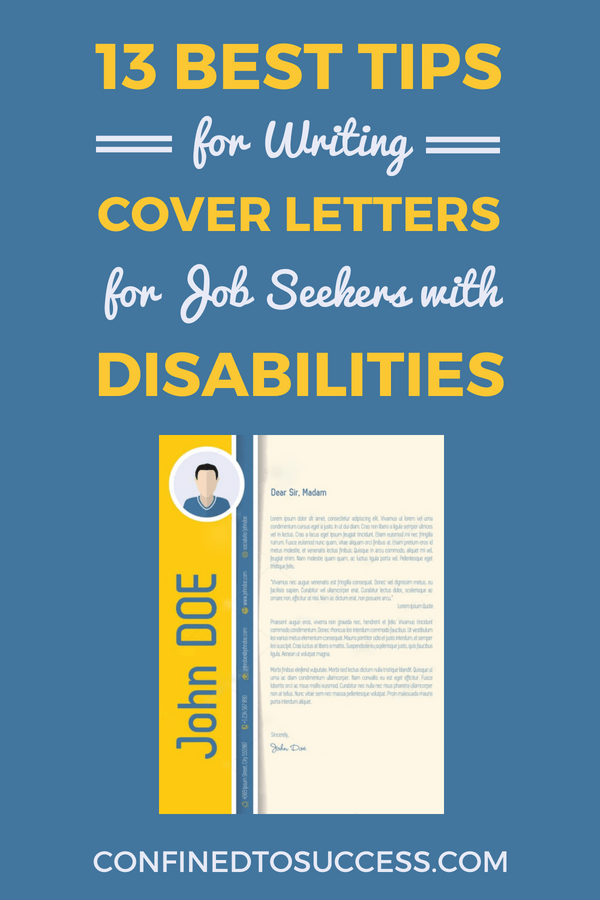How To Write A Cover Letter For Job Seekers With Disabilities

While everyone expects to have to submit a resume at some point during the job application and interviewing process, the same can’t always be said when it comes to a cover letter. Use the following guidelines to determine if the job you’re applying for as a job seeker with a disability would benefit from having a cover letter and, if so, how to write an effective one.
It’s extremely important to know that not every job will require a cover letter. It’s also valuable to understand what’s appropriate to include in a cover letter and what may best be left off entirely, especially for a job seeker with a disability. With that said, here are 13 tips that may help you…
1. Find Out Whether the Company Requires a Cover Letter
Unless specifically asked for in the job description, there’s no requirement that every resume be accompanied by a cover letter. If writing a cover letter seems too daunting or gets in the way of just sending off a resume, it’s best to skip it.
2. Understand the Situations Where a Cover Letter is Needed
A cover letter may be a good idea under the following circumstances:
- When information vital to the job duties can’t easily be conveyed on a resume
- When you want someone to forward your resume to the correct person
- If you’re applying to creative positions or executive level positions
- If you’re applying for positions that may include several interviews with many different persons reviewing the resume. In this example, a cover letter can help the interviewers get to know you and give them an indication of how you present yourself.
3. Address Your Cover Letter to a Specific Person
Do some research online or call the company and ask for the name of the human resource recruiter or hiring manager for the position. A personalized letter shows the employer you’re resourceful and do your homework!
4. Name Drop in Your Cover Letter
Whether it’s a personal or general company email, be sure to name drop if you have a company contact or were referred by someone. It can be as simple as a starting line of “John Doe suggested I contact you.” Yet be sure to identify him if you think the recipient won’t know who John Doe is. For example, “John Doe, who works in Accounting, suggested that I contact you.”
5. Determine What Approach to Take with Your Cover Letter
The way to approach your cover letter depends on whether you have a contact with the employer or if it’s going to a general human resources’ company email:
- When sending to a personal email, let the focus be on the specific job description and why you’re a good fit. Highlight a few terms and use key words from the description that directly match your skills and abilities and express them in a paragraph or two.
- When sending to a general HR email (e.g., recruiter@company.com), focus as much on the company itself as the job description.
6. Know What Not to Include in Your Cover Letter
Job seekers with disabilities may be tempted to disclose their disability in a cover letter, but we strongly advise against it. At this point in the job search process, it’s simply not necessary.Be sure to only apply to positions where you meet the minimum requirements listed in the job posting. If you’re unable to meet these requirements, you may want to look for positions better suited to your skills and abilities instead. If you have areas in your work history related to a disability or illness, such as gaps in employment or a career change, you can address these on your resume. Just make sure not to disclose your disability on the resume.An employment network agency or professional job counselor specializing in helping people with disabilities can assist you with writing your resume and cover letter to fit your unique needs and guide you when to mention certain items during the job search.
7. Acknowledge Unique Situations in Your Cover Letter
Use your cover letter to point out special circumstances like being a recent graduate, recently laid off, or in the midst of transitioning careers. Keep it brief and simple. Here are a few examples:
Example 1 – Recent Graduate“As a graduate of XYZ School in Hotel Management, I am prepared to put my education into practice.”
Example 2 – Recent Lay Off“Due to reorganization at my previous company where I had been in management for six years, I am exploring management positions at your call center operations.”
Example 3 – Transitioning Careers“I have ten years successful sales experience as a real estate agent, and I would bring the same enthusiasm for sales and customer service to your equipment sales position.”
A specialty cover letter can also be used for veterans or those who need to address a gap in employment, like caring for a family member or living outside the country.
8. Pay Attention to Word Length in Your Cover Letter
Be as clear and brief as possible when using a cover letter. Remember, the goal of the cover letter is only to call attention to your resume and interest in a specific job or company. Try to keep it simple by highlighting the key reasons why you’re a good fit for the job. Here are two examples:
Example 1“Thanks for considering me for your Accounting Clerk position. I have ten years experience and excel in a fast-paced environment with lots of teamwork. Attached is my resume.”
Example 2“Thanks for considering me for your IT position. I have both Microsoft certifications you require as well as the security clearance level needed for this position. I look forward to meeting you for the opportunity to discuss my experience and unique ways I can contribute to your company.”
9. Use Bullet Points Where Appropriate in Your Cover Letter
Consider highlighting your skills or key words with bullet points. Just be sure not to repeat the same bullets from your resume and keep it general enough to peak interest in learning more about you. Here’s an example:
“While my attached resume provides a good overview of my background, I have also outlined some of my strengths relevant to your Legal Receptionist position.”
- 2 Years Law Office Experience
- Positive and Cheerful Personality with Outstanding Phone Etiquette
- Skilled with ATT8000 Series Communication System
- Ability to Manage Busy Phone Lines
10. List Your Contact Information And Mention That You’ll Follow Up
Be sure to include your name, address, and phone number in every cover letter. This makes it easy for the employer to contact you for questions or for an interview. To match styles, you may be able to copy and paste the heading from your resume as a template for your cover letter.
If, however, you’re emailing your resume, use the text of the email for the cover letter and only include your phone number after your name. The resume will provide your full contact information.
Also, let the employer know that you intend to follow up. Here’s an example:
“Since my background and skills fit your requirements so closely, I will call to arrange a meeting with you in the next few days or week.”
Be sure to then follow through to demonstrate that you’re a responsible person.
11. Find Out the Best Way to Submit Your Cover Letter
In today’s world, employers typically have a specific submission process for resumes and/or applications. Most applications are submitted online or through email, but some employers still use faxes or leave space on an application for additional comments.
12. Use the Email Content Box for Your Cover Letter Message
If you’re going to email your resume, don’t also attach a cover letter document. Instead, type or copy your cover letter in the text of the email message.
13. Use a Standard Fax Cover Sheet and Add a Personal Note
If you’re going to fax your resume and cover letter, make sure to use a cover sheet. A standard fax cover sheet includes separate lines for recipient, sender, subject, and number of pages including the cover sheet. Here’s an example:
To: Sandy Smith, Hiring ManagerFrom: Lila ThomasSubject: Administrative Assistant PositionTotal Pages Faxed: 3
If you have good handwriting, consider including a handwritten note as well (typing it can also work), with just a few words such as “Hope to talk to you soon!” or “Thanks for taking a look at my resume. Feel free to call me with any questions.”
May these 13 guidelines help steer you in the right direction with your cover letter and help secure the job you want! Leave your comments and questions below!
ABOUT THE AUTHOR: Paula Reuben Vieillet is a Certified Vocational Counselor and Founder and President of Employment Options, an authorized SSA Employment Network (EN) providing national and virtual job placement in both Work At Home and Community positions. They specifically assist those citizens receiving SSDI or SSI disability in finding suitable employment in 47 states. Search current job openings and apply for free Ticket To Work services by going to www.MyEmploymentOptions.com. Paula is also the author of several career workbooks including “Employment Options: The Ultimate Resource for Job Seekers with Disabilities and Other Challenges.”

![Is Opinion Outpost Legit Or A Scam? [Truth Revealed!]](https://parentportfolio.com/wp-content/uploads/2018/08/opinion-outpost-legit-scam.png)





